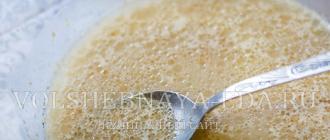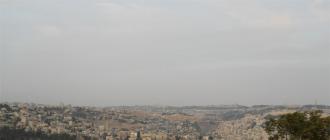Topic: “Polygons. Types of polygons”
9th grade
SHL No. 20
Teacher: Kharitonovich T.I. Purpose of the lesson: study types of polygons.
Learning task: update, expand and generalize students’ knowledge about polygons; form an idea of the “component parts” of a polygon; conduct a quantity survey constituent elements regular polygons (from triangle to n-gon);
Developmental task: develop the ability to analyze, compare, draw conclusions, develop computational skills, oral and written mathematical speech, memory, as well as independence in thinking and educational activities, ability to work in pairs and groups; develop research and educational activities;
Educational task: cultivate independence, activity, responsibility for the assigned work, perseverance in achieving the goal.
Equipment: interactive whiteboard (presentation)
Lesson progress
Presentation showing: “Polygons”
“Nature speaks the language of mathematics, the letters of this language ... mathematical figures.” G.Galliley
At the beginning of the lesson, the class is divided into working groups (in our case, divided into 3 groups)
1.Call stage-
a) updating students’ knowledge on the topic;
b) awakening interest in the topic being studied, motivating each student for educational activities.
Technique: Game “Do you believe that...”, organization of work with text.
Forms of work: frontal, group.
“Do you believe that...”
1. ... the word “polygon” indicates that all the figures in this family have “many angles”?
2. ... does a triangle belong to a large family of polygons, distinguished among the variety of different geometric shapes on a plane?
3. ... is a square a regular octagon (four sides + four corners)?
Today in the lesson we will talk about polygons. We learn that this figure is limited by a closed broken line, which in turn can be simple, closed. Let's talk about the fact that polygons can be flat, regular, or convex. One of the flat polygons is a triangle, with which you have long been familiar (you can show students posters depicting polygons, a broken line, show them various types, you can also use TSO).
2. Conception stage
Goal: obtaining new information, understanding it, selecting it.
Technique: zigzag.
Forms of work: individual->pair->group.
Each member of the group is given a text on the topic of the lesson, and the text is compiled in such a way that it includes both information already known to the students and information that is completely new. Along with the text, students receive questions, the answers to which must be found in this text.
Polygons. Types of polygons.
Who hasn't heard of the mysterious Bermuda Triangle, in which ships and planes disappear without a trace? But the triangle, familiar to us from childhood, is fraught with a lot of interesting and mysterious things.
In addition to the types of triangles already known to us, divided by sides (scalene, isosceles, equilateral) and angles (acute, obtuse, rectangular), the triangle belongs to a large family of polygons, distinguished among many different geometric shapes on the plane.
The word “polygon” indicates that all figures in this family have “many angles.” But this is not enough to characterize the figure.
A broken line A1A2...An is a figure that consists of points A1,A2,...An and the segments A1A2, A2A3,... connecting them. The points are called the vertices of the polyline, and the segments are called the links of the polyline. (FIG.1)
A broken line is called simple if it has no self-intersections (Fig. 2, 3).
A polyline is called closed if its ends coincide. The length of a broken line is the sum of the lengths of its links (Fig. 4)
A simple closed broken line is called a polygon if its neighboring links do not lie on the same straight line (Fig. 5).
Substitute a specific number, for example 3, in the word “polygon” instead of the “many” part. You will get a triangle. Or 5. Then - a pentagon. Note that, as many angles as there are, there are as many sides, so these figures could well be called polylaterals.
The vertices of the broken line are called the vertices of the polygon, and the links of the broken line are called the sides of the polygon.
The polygon divides the plane into two areas: internal and external (Fig. 6).
A plane polygon or polygonal area is the finite part of a plane bounded by a polygon.
Two vertices of a polygon that are the ends of one side are called adjacent. Vertices that are not ends of one side are non-neighboring.
A polygon with n vertices, and therefore n sides, is called an n-gon.
Although smallest number There are 3 sides of a polygon. But triangles, when connected to each other, can form other figures, which in turn are also polygons.
Segments connecting non-adjacent vertices of a polygon are called diagonals.
A polygon is called convex if it lies in the same half-plane relative to any line containing its side. In this case, the straight line itself is considered to belong to the HALF PLANE
The angle of a convex polygon at a given vertex is the angle formed by its sides converging at this vertex.
Let's prove the theorem (about the sum of the angles of a convex n-gon): The sum of the angles of a convex n-gon is equal to 1800*(n - 2).
Proof. In the case n=3 the theorem is valid. Let A1A2...A n be a given convex polygon and n>3. Let's draw diagonals in it (from one vertex). Since the polygon is convex, these diagonals divide it into n – 2 triangles. The sum of the angles of a polygon is the sum of the angles of all these triangles. The sum of the angles of each triangle is 1800, and the number of these triangles n is 2. Therefore, the sum of the angles of the convex n triangle A1A2...A n is 1800* (n - 2). The theorem has been proven.
The exterior angle of a convex polygon at a given vertex is the angle adjacent to the interior angle of the polygon at this vertex.
Convex polygon is called regular if all sides are equal and all angles are equal.
So the square can be called differently - a regular quadrilateral. Equilateral triangles are also correct. Such figures have long been of interest to craftsmen who decorated buildings. They made beautiful patterns, for example on parquet. But not all regular polygons could be used to make parquet. Parquet cannot be made from regular octagons. The fact is that each angle is equal to 1350. And if any point is the vertex of two such octagons, then their share will be 2700, and there is no place for the third octagon to fit there: 3600 - 2700 = 900. But for a square this is enough. Therefore, you can make parquet from regular octagons and squares.
The stars are also correct. Our five-pointed star is a regular pentagonal star. And if you rotate the square around the center by 450, you get a regular octagonal star.

What is a broken line? Explain what vertices and links of a polyline are.
Which broken line is called simple?
Which broken line is called closed?
What is a polygon called? What are the vertices of a polygon called? What are the sides of a polygon called?
Which polygon is called flat? Give examples of polygons.
What is n – square?
Explain which vertices of a polygon are adjacent and which are not.
What is the diagonal of a polygon?
Which polygon is called convex?
Explain which angles of a polygon are external and which are internal?
Which polygon is called regular? Give examples of regular polygons.
What is the sum of the angles of a convex n-gon? Prove it.
Students work with the text, look for answers to the questions posed, after which expert groups are formed, in which work is carried out on the same issues: students highlight the main points, draw up a supporting summary, and present information in one of the graphic forms. Upon completion of work, students return to their work groups.
3. Reflection stage -
a) assessment of one’s knowledge, challenge to the next step of knowledge;
b) comprehension and appropriation of the information received.
Reception: research work.
Forms of work: individual->pair->group.
Working groups include specialists in answering each section of the proposed questions.
Returning to the working group, the expert introduces the answers to his questions to other group members. The group exchanges information between all members of the working group. Thus, in every working group, thanks to the work of experts, it is taking shape general idea on the topic being studied.
Research work students– filling out the table.
Regular polygons Drawing Number of sides Number of vertices Sum of all internal angles Degree measure internal angle Degree measure of external angle Number of diagonals
A) triangle
B) quadrilateral
B) five-hole
D) hexagon
D) n-gon
Solving interesting problems on the topic of the lesson.
1) How many sides does it have? regular polygon, each of internal corners which is equal to 1350?
2) In a certain polygon, all interior angles are equal to each other. Can the sum of the interior angles of this polygon be: 3600, 3800?
3) Is it possible to build a pentagon with angles of 100,103,110,110,116 degrees?
Summing up the lesson.
Record homework: PAGE 66-72 No. 15,17 AND TASK: IN A QUADRIAGON, DRAW A STRAIGHT LINE SO THAT IT DIVIDES IT INTO THREE TRIANGLES.
Reflection in the form of tests (on the interactive whiteboard)
§ 1 The concept of a triangle
In this lesson you will become familiar with such shapes as triangles and polygons.
If three points that do not lie on the same line are connected by segments, you get a triangle. A triangle has three vertices and three sides.
Before you is a triangle ABC, it has three vertices (point A, point B and point C) and three sides (AB, AC and CB).
By the way, these same sides can be called differently:
AB=BA, AC=SA, CB=BC.
The sides of the triangle form three angles at the vertices of the triangle. In the figure you see angle A, angle B, angle C.
So the triangle is geometric figure, formed by three segments that connect three points that do not lie on the same straight line.
§ 2 The concept of a polygon and its types
In addition to triangles, there are quadrangles, pentagons, hexagons, and so on. In a word, they can be called polygons.
In the figure you see the quadrilateral DMKE.
Points D, M, K and E are the vertices of the quadrilateral.
The segments DM, MK, KE, ED are the sides of this quadrilateral. Just as in the case of a triangle, the sides of a quadrilateral form four angles at the vertices, as you guessed, hence the name - quadrilateral. For this quadrilateral you see in the figure angle D, angle M, angle K and angle E.
What quadrilaterals do you already know?
Square and rectangle! Each of them has four corners and four sides.

Another type of polygon is the pentagon.
The points O, P, X, Y, T are the vertices of the pentagon, and the segments TO, OP, PX, XY, YT are the sides of this pentagon. A pentagon has respectively five angles and five sides.
How many angles and how many sides do you think a hexagon has? That's right, six! Reasoning in a similar way, we can say how many sides, vertices or angles a particular polygon has. And we can conclude that a triangle is also a polygon, which has exactly three angles, three sides and three vertices.
Thus, in this lesson you became acquainted with such concepts as triangle and polygon. We learned that a triangle has 3 vertices, 3 sides and 3 angles, a quadrilateral has 4 vertices, 4 sides and 4 angles, a pentagon has 5 sides, 5 vertices, 5 angles, and so on.
List of used literature:
- Mathematics 5th grade. Vilenkin N.Ya., Zhokhov V.I. and others. 31st ed., erased. - M: 2013.
- Didactic materials for mathematics grade 5. Author - Popov M.A. - 2013
- We calculate without errors. Work with self-test in mathematics grades 5-6. Author - Minaeva S.S. - 2014
- Didactic materials for mathematics grade 5. Authors: Dorofeev G.V., Kuznetsova L.V. - 2010
- Control and independent work in mathematics 5th grade. Authors - Popov M.A. - 2012
- Mathematics. 5th grade: educational. for general education students. institutions / I. I. Zubareva, A. G. Mordkovich. - 9th ed., erased. - M.: Mnemosyne, 2009

The part of the plane bounded by a closed broken line is called a polygon.
The segments of this broken line are called parties polygon. AB, BC, CD, DE, EA (Fig. 1) are the sides of the polygon ABCDE. The sum of all the sides of a polygon is called its perimeter.
The polygon is called convex, if it is located on one side of any of its sides, indefinitely extended beyond both vertices.
The MNPKO polygon (Fig. 1) will not be convex, since it is located on more than one side of the straight line KR.

We will only consider convex polygons.
The angles formed by two adjacent sides of a polygon are called its internal corners, and their tops are vertices of the polygon.
A straight line segment connecting two non-adjacent vertices of a polygon is called the diagonal of the polygon.
AC, AD - diagonals of the polygon (Fig. 2).
Angles adjacent to the interior angles of a polygon are called exterior angles of the polygon (Fig. 3).
Depending on the number of angles (sides), the polygon is called a triangle, quadrilateral, pentagon, etc.
Two polygons are said to be congruent if they can be brought together by overlapping.
Inscribed and circumscribed polygons
If all the vertices of a polygon lie on a circle, then the polygon is called inscribed into a circle, and the circle - described near the polygon (fig).

If all sides of a polygon are tangent to a circle, then the polygon is called described about a circle, and the circle is called inscribed into a polygon (Fig.).
Similarity of polygons
Two polygons of the same name are called similar if the angles of one of them are respectively equal to the angles of the other, and the similar sides of the polygons are proportional.
Polygons with the same number of sides (angles) are called polygons of the same name.
The sides of similar polygons connecting the vertices respectively are called similar. equal angles(rice).

So, for example, for the polygon ABCDE to be similar to the polygon A'B'C'D'E', it is necessary that: ∠A = ∠A' ∠B = ∠B' ∠C = ∠C' ∠D = ∠D' ∠ E = ∠E' and, in addition, AB / A'B' = BC / B'C' = CD / C'D' = DE / D'E' = EA / E'A' .
Ratio of perimeters of similar polygons
First, consider the property of a series of equal ratios. Let us, for example, have the following ratios: 2 / 1 = 4 / 2 = 6 / 3 = 8 / 4 =2.
Let's find the sum of the previous terms of these relations, then the sum of their subsequent terms and find the ratio of the resulting sums, we get:
$$ \frac(2 + 4 + 6 + 8)(1 + 2 + 3 + 4) = \frac(20)(10) = 2 $$
We get the same thing if we take a series of some other relations, for example: 2 / 3 = 4 / 6 = 6 / 9 = 8 / 12 = 10 / 15 = 2 / 3 Let’s find the sum of the previous terms of these relations and the sum of the subsequent ones, and then find the ratio of these sums, we get:
$$ \frac(2 + 4 + 5 + 8 + 10)(3 + 6 + 9 + 12 + 15) = \frac(30)(45) = \frac(2)(3) $$
In both cases, the sum of the previous members of a series of equal relations relates to the sum of subsequent members of the same series, just as the previous member of any of these relations relates to its subsequent one.
We derived this property by considering the series numerical examples. It can be derived strictly and in a general form.
Now consider the ratio of the perimeters of similar polygons.
Let the polygon ABCDE be similar to the polygon A’B’C’D’E’ (Fig).

From the similarity of these polygons it follows that
AB / A’B’ = BC / B’C’ = CD / C’D’ = DE / D’E’ = EA / E’A’
Based on the property we derived for a series of equal ratios, we can write:
The sum of the previous terms of the relations we have taken represents the perimeter of the first polygon (P), and the sum of the subsequent terms of these relations represents the perimeter of the second polygon (P’), which means P / P’ = AB / A’B’.
Hence, The perimeters of similar polygons are related to their similar sides.
Ratio of areas of similar polygons
Let ABCDE and A’B’C’D’E’ be similar polygons (Fig).

It is known that ΔАВС ~ ΔA'В'С' ΔACD ~ ΔA'C'D' and ΔADE ~ ΔA'D'E'.
Besides,
![]() ;
;
Since the second ratios of these proportions are equal, which follows from the similarity of polygons, then
Using the property of a series of equal ratios we get:
Or ![]()
where S and S’ are the areas of these similar polygons.
Hence, The areas of similar polygons are related as the squares of similar sides.
The resulting formula can be converted to this form: S / S’ = (AB / A’B’) 2
Area of an arbitrary polygon
Let it be necessary to calculate the area of an arbitrary quadrilateral ABC (Fig.).

Let's draw a diagonal in it, for example AD. We get two triangles ABD and ACD, the areas of which we can calculate. Then we find the sum of the areas of these triangles. The resulting sum will express the area of the given quadrilateral.
If you need to calculate the area of a pentagon, then we do the same thing: we draw diagonals from one of the vertices. We get three triangles, the areas of which we can calculate. This means we can find the area of this pentagon. We do the same when calculating the area of any polygon.
Projected area of a polygon
Let us recall that the angle between a line and a plane is the angle between a given line and its projection onto the plane (Fig.).

Theorem. The area of the orthogonal projection of a polygon onto a plane is equal to the area of the projected polygon multiplied by the cosine of the angle formed by the plane of the polygon and the projection plane.
Each polygon can be divided into triangles whose sum of areas is equal to the area of the polygon. Therefore, it is enough to prove the theorem for a triangle.
Let ΔАВС be projected onto the plane r. Let's consider two cases:
a) one of the sides ΔABC is parallel to the plane r;
b) none of the sides ΔABC are parallel r.
Let's consider first case: let [AB] || r.

Let us draw a plane through (AB) r 1 || r and project orthogonally ΔАВС on r 1 and on r(rice.); we get ΔАВС 1 and ΔА'В'С'.
By the property of projection we have ΔАВС 1 (cong) ΔА'В'С', and therefore
S Δ ABC1 = S Δ A’B’C’
Let's draw ⊥ and the segment D 1 C 1 . Then ⊥ , a \(\overbrace(CD_1C_1)\) = φ is the value of the angle between the plane ΔABC and the plane r 1. That's why
S Δ ABC1 = 1 / 2 | AB | | C 1 D 1 | = 1 / 2 | AB | | CD 1 | cos φ = S Δ ABC cos φ
and therefore S Δ A’B’C’ = S Δ ABC cos φ.
Let's move on to consider second case. Let's draw a plane r 1 || r through that vertex ΔАВС, the distance from which to the plane r the smallest (let this be vertex A).
Let's project ΔАВС on the plane r 1 and r(rice.); let its projections be ΔАВ 1 С 1 and ΔА'В'С', respectively.

Let (BC) ∩ p 1 = D. Then
S Δ A’B’C’ = S ΔAB1 C1 = S ΔADC1 - S ΔADB1 = (S ΔADC - S ΔADB) cos φ = S Δ ABC cos φ
Other materialsIn the course of geo-metry, we study the properties of geo-metric figures and have already looked at the simplest of them: triangles and surroundings. At the same time, we also discussed specific special cases of these figures, such as rectangular, equal and right tri-coal-ni-ki. Now the time has come to talk about more general and complex figures - a lot of coal.
With a private case a lot of coal we already know - this is a triangle (see Fig. 1).
Rice. 1. Triangle
The name itself already suggests that it is a fi-gu-ra, which has three corners. Next, in a lot of coal there can be many of them, i.e. more than three. For example, draw a pentagon (see Fig. 2), i.e. fi-gu-ru with five corners-la-mi.

Rice. 2. Penta-corner. You-bulky polygon
Definition.Polygon- figure, consisting of several points (more than two) and corresponding to the number of points from the kov, who follow them together. These points are called top-she-on-mi a lot of coal, but from cutting - hundred-ro-na-mi. In this case, no two adjacent sides lie on the same straight line and no two non-adjacent sides intersect .
Definition.Right polygon- this is a convex polygon, which has all the sides and angles equal.
Any polygon divides the plane into two areas: internal and external. The internal area is also from a lot of coal.
In other words, for example, when they talk about the pentagon, they mean both its entire internal region and its borders. tsu. And all the points that lie inside a lot of coal are related to the inner region, i.e. the point is also from-no-sit-xia to the five-coal-ni-ku (see Fig. 2).
A lot of coal is sometimes called n-coal to emphasize that it is common the case of an unknown number of angles (n pieces).
Definition. Peri-meter of many-coal-no-ka- the sum of the lengths of the sides of a lot of coal.
Now we need to get acquainted with the sights of a lot of coals. They are divided into you fart And farts. For example, the polygon shown in Fig. 2, you appear to be farting, and in Fig. 3 not fart.

Rice. 3. Nevy-bumpy polygon
2. Convex and non-convex polygons
Definition 1. Polygon na-za-va-et-sya you fart, if, when passing through a direct line through any of its sides, the entire polygon lies only on one side of this straight line. Neva-puk-ly-mi everyone else appears a lot of coal.
It is easy to imagine that when extending any side of the five-corner in Fig. 2 it will all end up on one side of this straight line, i.e. he's farty. But when passing straight through the four-coal in Fig. 3 we already see that she divides it into two parts, i.e. he's not a fart.
But there is another definition of how much coal you have.
Definition 2. Polygon na-za-va-et-sya you fart, if when you select any two of its internal points and when connecting them from a cut, all points from the cut are also internal - not exactly a lot of coal.
A demonstration of the use of this definition can be seen in the example of the construction of cut-offs in Fig. 2 and 3.
Definition. Dia-go-na-lew a lot of coal is called any cut that connects two non-adjacent tops of it.
3. Theorem on the sum of interior angles of a convex n-gon
To describe the properties of polygons, there are two important theorems about their angles: theo-re-ma about the sum of the internal angles of a lot of angles And theo-re-ma about the sum of external angles of a lot of angles. Let's look at them.
Theorem. About the sum of the internal angles you have a lot of angles (n-coal-no-ka).
Where is the number of its angles (sides).
Proof 1. Illustration in Fig. 4 protruding n-gon.

Rice. 4. You-bumpy n-gon
From the top we will conduct all possible dia-gos. They divide n-gon-nik into tri-gon-nik, because. Each of the sides forms a lot of coal, except for the sides lying towards the top. It is easy to see from the figure that the sum of the angles of all these triangles will be exactly equal to the sum of the internal angles of the n-corner. Since the sum of the angles of any triangle is , then the sum of the internal angles of an n-angle:
Reason 2. It is possible that there is another reason for this theorem. Illustration of an analogous n-gon in Fig. 5 and connect any of its internal points with all the vertices.

We have divided the n-coal into n triangles (how many sides, so many triangles) ). The sum of all their angles is equal to the sum of the internal angles of the polygon and the sum of the angles at the internal point, and this is the angle. We have:
Q.E.D.
Do-ka-za-but.
According to the previous theory, it is clear that the sum of the angles n-coal does not depend on the number of its sides (from n). For example, in a triangle, the sum of the angles is . In wh-reh-coal-no-ke, and the sum of the angles - etc.
4. Theorem on the sum of external angles of a convex n-gon
Theorem. About the sum of the external angles of a lot of coal (n-coal-no-ka).
Where is the number of its angles (sides), and , ..., are the external angles.
Proof. The image of a convex n-gon in Fig. 6 and designate its internal and external angles.

Rice. 6. You-convex n-gon with designated external corners
Because the external angle is connected with the internal angle as adjacent, then ![]() and similar for the other external corners. Then:
and similar for the other external corners. Then:
During the pre-development, we have already used the theorem about the sum of internal angles n-coal-ni- ka.
Do-ka-za-but.
From the previous theorem it follows an interesting fact that the sum of the external angles of the convex n-coal is equal to ![]() on the number of its angles (sides). By the way, depending on the sum of the internal angles.
on the number of its angles (sides). By the way, depending on the sum of the internal angles.
Next, we will work in more detail with the particular case of a lot of coal - why-you-re-re-coal-no-mi. In the next lesson, we will get to know such a figure as par-ral-le-lo-gram, and discuss its properties.
SOURCE
http://interneturok.ru/ru/school/geometry/8-klass/chyotyrehugolniki/mnogougolniki
http://interneturok.ru/ru/school/geometry/8-klass/povtorenie/pryamougolnye-treugolniki
http://interneturok.ru/ru/school/geometry/8-klass/povtorenie/treugolniki-2
http://nsportal.ru/shkola/geometriya/library/2013/10/10/mnogougolniki-urok-v-8-klasse
https://im0-tub-ru.yandex.net/i?id=daa2ea7bbc3c92be3a29b22d8106e486&n=33&h=190&w=144
Maintaining your privacy is important to us. For this reason, we have developed a Privacy Policy that describes how we use and store your information. Please review our privacy practices and let us know if you have any questions.
Collection and use of personal information
Personal information refers to data that can be used to identify or contact a specific person.
You may be asked to provide your personal information at any time when you contact us.
Below are some examples of the types of personal information we may collect and how we may use such information.
What personal information do we collect:
- When you submit an application on the site, we may collect various information, including your name, telephone number, address email etc.
How we use your personal information:
- The personal information we collect allows us to contact you and inform you about unique offers, promotions and other events and upcoming events.
- From time to time, we may use your personal information to send important notices and communications.
- We may also use personal information for internal purposes, such as conducting audits, data analysis and various research in order to improve the services we provide and provide you with recommendations regarding our services.
- If you participate in a prize draw, contest or similar promotion, we may use the information you provide to administer such programs.
Disclosure of information to third parties
We do not disclose the information received from you to third parties.
Exceptions:
- If necessary - in accordance with the law, judicial procedure, legal proceedings, and/or based on public requests or requests from government agencies on the territory of the Russian Federation - disclose your personal information. We may also disclose information about you if we determine that such disclosure is necessary or appropriate for security, law enforcement, or other public importance purposes.
- In the event of a reorganization, merger, or sale, we may transfer the personal information we collect to the applicable successor third party.
Protection of personal information
We take precautions - including administrative, technical and physical - to protect your personal information from loss, theft, and misuse, as well as unauthorized access, disclosure, alteration and destruction.
Respecting your privacy at the company level
To ensure that your personal information is secure, we communicate privacy and security standards to our employees and strictly enforce privacy practices.






